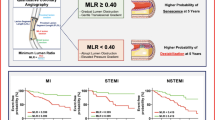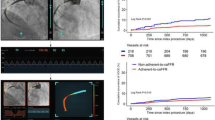Abstract
Objective evaluation of the functional significance of individual stenosis in patients with multiple lesions is crucial when performing percutaneous coronary intervention (PCI). Here we propose a novel lesion-specific parameter, the epicardial resistance index (ERI), which is derived from intracoronary pressure measurements, and validate its clinical usefulness. The ERI is defined as the ratio of the resistance of an epicardial coronary stenosis to that of downstream myocardium. After obtaining intracoronary pressure data by pull-back of a 0.014″ pressure wire, the ERI was calculated as the trans-lesional pressure gradient divided by (Pd–Pv) at maximum hyperemia, where Pd = the mean distal coronary pressure in the absence of any stenosis and Pv = the central venous pressure. Using 170 measurements obtained from 75 patients, the correlation of ERI with parameters obtained from quantitative coronary angiography (QCA) and intravascular ultrasound (IVUS) was studied. ERI showed a significant correlation with the QCA-derived percent diameter stenosis (r = 0.67, P < 0.001), and with the IVUS-derived minimum luminal area (r = 0.68, P < 0.001). In 55 patients who underwent PCI with bare metal stents, a postprocedural target lesion ERI value greater than 0.16 strongly predicted the need for subsequent revascularization within six months (81% sensitivity and 80% specificity). The ERI is a useful pressure-derived hemodynamic parameter that correlates with anatomical parameters. In addition, the postprocedural resistance of the target lesion indicated by the ERI is a reliable predictor of the late outcome of PCI.
Similar content being viewed by others
References
NH Pijls B Van Gelder P Van Der Voort K PeEls FA Bracke HJ Bonnier MI El Gamal (1995) ArticleTitleFractional flow reserve. A useful index to evaluate the influence of an epicardial coronary stenosis on myocardial blood flow [see comments] Circulation 92 3183–3193 Occurrence Handle7586302 Occurrence Handle1:STN:280:DyaK28%2FotVSksg%3D%3D
NH Pijls B De Bruyne K Peels PH Van Der Voort HJ Bonnier JKJJ Bartunek JJ Koolen (1996) ArticleTitleMeasurement of fractional flow reserve to assess the functional severity of coronary-artery stenoses New England Journal of Medicine 334 1703–1708 Occurrence Handle8637515 Occurrence Handle10.1056/NEJM199606273342604 Occurrence Handle1:STN:280:DyaK283ktVGgsw%3D%3D
A Takagi Y Tsurumi Y Ishii K Suzuki M Kawana H Kasanuki (1999) ArticleTitleClinical potential of intravascular ultrasound for physiological assessment of coronary stenosis: relationship between quantitative ultrasound tomography and pressure-derived fractional flow reserve Circulation 100 250–255 Occurrence Handle10411848 Occurrence Handle1:STN:280:DyaK1MzktF2htw%3D%3D
S Suemaru K Iwasaki K Yamamoto S Kusachi K Hina S Hirohata M Hirota M Murakami S Kamikawa T Murakami Y Shiratori (2005) ArticleTitleCoronary pressure measurement to deter-mine treatment strategy for equivocal left main coronary artery lesions Heart and Vessels 20 271–277 Occurrence Handle16314909 Occurrence Handle10.1007/s00380-005-0849-1
B De Bruyne NH Pijls GR Heyndrickx D Hodeige R Kirkeeide KL Gould (2000) ArticleTitlePressure-derived fractional flow reserve to assess serial epicardial stenoses: theoretical basis and animal validation Circulation 101 1840–1847 Occurrence Handle10769286 Occurrence Handle1:STN:280:DC%2BD3c3jtlyitw%3D%3D
GJ Bech NH Pijls B De Bruyne KH Peels HR Michels HJ Bonnier JJ Koolen (1999) ArticleTitleUsefulness of fractional flow reserve to predict clinical outcome after balloon angioplasty Circulation 99 883–888 Occurrence Handle10027810 Occurrence Handle1:STN:280:DyaK1M7lt1SksA%3D%3D
PW Serruys C di Mario J Piek E Schroeder C Vrints P Probst B De Bruyne C Hanet E Fleck M Haude E Verna V Voudris H Geschwind H Emanuelsson V Muhlberger G Danzi HO Peels AJ Ford SuffixJr E Boersma (1997) ArticleTitlePrognostic value of intracoronary flow velocity and diameter stenosis in assessing the short- and long-term outcomes of coronary balloon angioplasty: the DEBATE Study (Doppler Endpoints Balloon Angioplasty Trial Europe) Circulation 96 3369–3377 Occurrence Handle9396429 Occurrence Handle1:STN:280:DyaK1c%2FlslWitw%3D%3D
NHJ Pijls B De Bruyne GJW Bech F Liistro GR Heyndrickx HJRM Bonnier JJ Koolen (2000) ArticleTitleCoronary pressure measurement to assess the hemodynamic significance of serial stenosis within one coronary artery: Validation in humans Circulation 102 2371–2377 Occurrence Handle11067791 Occurrence Handle1:STN:280:DC%2BD3crhtlWnsg%3D%3D
C Lamm M Dohnal PW Serruys H Emanuelsson (1993) ArticleTitleHigh-fidelity translesional pressure gradients during percutaneous transluminal coronary angioplasty: correlation with quantitative coronary angiography Am Heart J 126 66–75 Occurrence Handle8322693 Occurrence Handle1:STN:280:DyaK3szhtFegsw%3D%3D
HV Anderson GS Roubin PP Leimgruber WR Cox JS Douglas SuffixJr King SBd AR Gruentzig (1986) ArticleTitleMeasurement of transstenotic pressure gradient during percutaneous transluminal coronary angioplasty Circulation 73 1223–1230 Occurrence Handle2938848 Occurrence Handle1:STN:280:DyaL287ptVCksA%3D%3D
D Atar PS Ramanujam K Saunamaki S Haunso (1994) ArticleTitleAssessment of coronary artery stenosis pressure gradient by quantitative coronary arteriography in patients with coronary artery disease Clin Physiol 14 23–35 Occurrence Handle8149707 Occurrence Handle1:STN:280:DyaK2c7pvF2gsA%3D%3D
B De Bruyne NH Pijls WJ Paulus PJ Vantrimpont SU Sys GR Heyndrickx (1993) ArticleTitleTransstenotic coronary pressure gradient measurement in humans: in vitro and in vivo evaluation of a new pressure monitoring angioplasty guide wire Journal of the Am Coll Cardiol 22 119–126 Occurrence Handle1:STN:280:DyaK3s3os1artA%3D%3D Occurrence Handle10.1016/0735-1097(93)90825-L
A Abizaid GS Mintz AD Pichard KM Kent LF Satler CL Walsh JJ Popma MB Leon (1998) ArticleTitleClinical, intravascular ultrasound, and quantitative angiographic determinants of the coronary flow reserve before and after percutaneous transluminal coronary angioplasty Am J Cardiol 82 423–428 Occurrence Handle9723627 Occurrence Handle10.1016/S0002-9149(98)00355-5 Occurrence Handle1:STN:280:DyaK1czovFShsg%3D%3D
JW Moses C Undermir JE Strain EM Kreps JE Higgins GW Gleim MJ Kern (1998) ArticleTitleRelation between single tomographic intravascular ultrasound image parameters and intracoronary Doppler flow velocity in patients with intermediately severe coronary stenoses Am Heart J 135 988–994 Occurrence Handle9630102 Occurrence Handle10.1016/S0002-8703(98)70063-8 Occurrence Handle1:STN:280:DyaK1c3pt1Smtg%3D%3D
JH Reiber PW Serruys CJ Kooijman W Wijns CJ Slager JJ Gerbrands JC Schuurbiers A den Boer PG Hugenholtz (1985) ArticleTitleAssessment of short-, medium-, and long-term variations in arterial dimensions from computer-assisted quantitation of coronary cineangiograms Circulation 71 280–288 Occurrence Handle3965172 Occurrence Handle1:STN:280:DyaL2M%2FnsV2gsA%3D%3D
JC Gurley SE Nissen DC Booth AN DeMaria (1992) ArticleTitleInfluence of operator- and patient-dependent variables on the suitability of automated quantitative coronary arteriography for routine clinical use J Am Coll Cardiol 19 1237–1243 Occurrence Handle1564224 Occurrence Handle1:STN:280:DyaK383is1ekug%3D%3D Occurrence Handle10.1016/0735-1097(92)90330-P
Y Ozaki AG Violaris T Kobayashi D Keane E Camenzind C Di Mario P de Feyter JR Roelandt PW Serruys (1997) ArticleTitleComparison of coronary luminal quantification obtained from intracoronary ultrasound and both geometric and videodensitometric quantitative angiography before and after balloon angioplasty and directional atherectomy Circulation 96 491–499 Occurrence Handle9244217 Occurrence Handle1:STN:280:DyaK2szos1elug%3D%3D
C von Birgelen MJ Kutryk R Gil Y Ozaki C Di Mario JR Roelandt PJ de Feyter PW Serruys (1996) ArticleTitleQuantification of the minimal luminal cross-sectional area after coronary stenting by two- and three-dimensional intravascular ultrasound versus edge detection and videodensitometry Am J Cardiol 78 520–525 Occurrence Handle8806335 Occurrence Handle10.1016/S0002-9149(96)00356-6 Occurrence Handle1:STN:280:DyaK28zpvF2muw%3D%3D
J Bartunek SU Sys GR Heyndrickx NH Pijls B De Bruyne (1995) ArticleTitleQuantitative coronary angiography in predicting functional significance of stenoses in an unselected patient cohort J Am Coll Cardiol 26 328–334 Occurrence Handle7608431 Occurrence Handle10.1016/0735-1097(95)80003-Y Occurrence Handle1:STN:280:DyaK2Mzjt1Kjsg%3D%3D
PP Leimgruber GS Roubin J Hollman GA Cotsonis B Meier JS Douglas SB King SuffixJr AR Gruentzig (1986) ArticleTitleRestenosis after successful coronary angioplasty in patients with single-vessel disease Circulation 73 710–717 Occurrence Handle2936532 Occurrence Handle1:STN:280:DyaL287jsVSkuw%3D%3D
JM Hodgson S Reinert AS Most DO Williams (1986) ArticleTitlePrediction of long-term clinical outcome with final translesional pressure gradient during coronary angioplasty Circulation 74 563–566 Occurrence Handle2943534 Occurrence Handle1:STN:280:DyaL283pvV2ksA%3D%3D
J Honye DJ Mahon A Jain CJ White SR Ramee JB Wallis A Al-Zarka JM Tobis (1992) ArticleTitleMorphological effects of coronary balloon angioplasty in vivo assessed by intravascular ultrasound imaging Circulation 85 1012–1025 Occurrence Handle1537099 Occurrence Handle1:STN:280:DyaK387msVSgtQ%3D%3D
Author information
Authors and Affiliations
Corresponding author
Rights and permissions
About this article
Cite this article
Suzuki, K., Tsurumi, Y., Fuda, Y. et al. Postprocedural resistance of the target lesion is a strong predictor of subsequent revascularization: assessment by a novel lesion-specific physiological parameter, the epicardial resistance index. Heart Vessels 22, 139–145 (2007). https://doi.org/10.1007/s00380-006-0945-x
Received:
Accepted:
Published:
Issue Date:
DOI: https://doi.org/10.1007/s00380-006-0945-x




